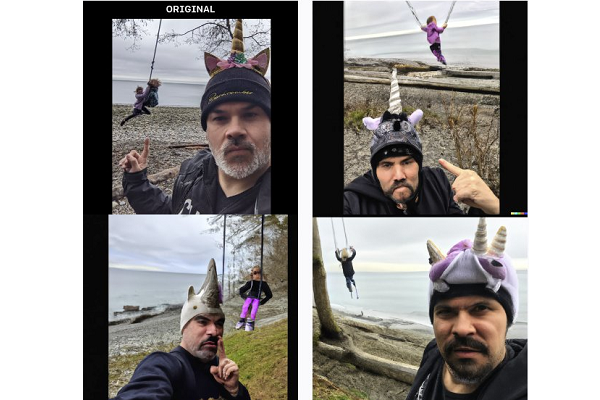OpenAI Starts Letting DALL-E 2 Users Edit Faces on Synthetic Images
Here’s me wearing my @beachcombercc toque and the girl’s unicorn headband while taking a selfie and paying important attention to rope swing safety 😅
…and the #dalle2 variations from that pic.twitter.com/NwtlyMBih2
— Allan Harding (@allanharding) September 20, 2022
People using OpenAI’s DALL-E 2 text-to-image engine can now upload and edit people’s faces. OpenAI had deliberately prevented faces from being included with the AI-powered synthetic media tool out of concern it would be misused, but now says upgraded safety software has mitigated those concerns.
Synthetic Faces
DALL-E 2 images hadn’t been entirely faceless until now, of course. But, only artificial, photorealistic faces were allowed. The company cited requests from users as the reason for pursuing better safety measures. Notably, OpenAI pointed to a reconstructive surgeon who uses DALL-E 2 to give patients an idea of what they will look like after a procedure and filmmakers who want to make production more efficient by editing images of scenes with people, as well as people who just want to play with fashion ideas using the AI tool. That said, only images of people that users have a right to or have consent from can be uploaded. That particular enforcement mechanism is not clear, though obviously, if such an image is published, the user would get in trouble for violating the terms of service. Misuse is an issue already plaguing DALL-E 2 rivals like Stable Diffusion, which lack the restrictions laid out by OpenAI.
“Many of you have told us that you miss using DALL-E to dream up outfits and hairstyles on yourselves and edit the backgrounds of family photos,” OpenAI explained in a letter to users. “With improvements in our safety system, DALL-E is now ready to support these delightful and important use cases – while minimizing the potential of harm from deepfakes. We made our filters more robust at rejecting attempts to generate sexual, political, and violent content – while also working to reduce false flags – and built new detection and response techniques to stop misuse.”
The latest option comes soon after OpenAI added a DALL-E feature called Outpainting that allows the AI to create a visualization of what might exist beyond the frame of an existing piece of art. AI-powered art had rapidly escalated in power and become a heated topic of debate, especially with stories about AI-generated art winning awards as a Midjourney-assisted painting did recently.
Follow @voicebotaiFollow @erichschwartz
OpenAI Teaches DALL-E Text-to-Image AI to Paint Beyond the Frame
Lightricks Adds AI Text-to-Image Generator to Photo Editing Mobile Apps









